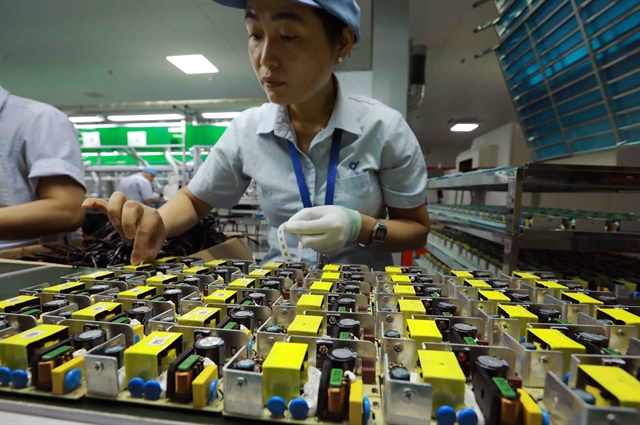 Economy
Economy

 |
| Workers assemble electronic components for the printing industry at Chee Yuen Electronics Technology Vietnam Co., Ltd., invested by Taiwan (China) in An Duong Industrial Park, An Duong District. — VNA/VNS Photo |
HCM CITY — More advanced manufacturing from Taiwan (China) will migrate to Việt Nam over the coming decades. The country, known as a prime destination for Taiwanese investment, has plenty of confidence to win contracts.
The shift in Taiwan (China) technology corporations' investment patterns in Việt Nam reflects broader geopolitical and economic trends. Since 2007, Taiwanese firms like Foxconn and Compal initially approached Việt Nam with cautious investments, often limited in scope. However, the US-China trade war, which began in 2017, significantly altered this trajectory.
As a result, many of the top Taiwanese electronics and technology corporations have increased their investments and expanded their operations in Việt Nam. This expansion is not just about scaling up, but also about establishing a more resilient and diversified supply chain. Companies like Foxconn, Pegatron, Wistron and others have played a crucial role in developing Việt Nam's northern regions into a significant technology production hub.
With the disruptions caused by the COVID-19 pandemic, many companies have reassessed their supply chains and diversified their sources to mitigate risks. This has led to a significant increase in the role of Việt Nam in the global electronics and technology sectors.
The country has become a strategic location for many Taiwanese technology companies, often referred to as 'eagles' due to their significant market presence and technological prowess.
The Ministry of Planning and Investment reports that, Taiwan (China) in 2023 quadrupled its investment into Việt Nam compared with 2022, reaching an impressive $2.2 billion.
According to economist from HSBC, to date Taiwan (China) is the fourth largest investor into Việt Nam, with nearly 3,200 projects and a total registered capital exceeding $39.5 billion. Additionally, Taiwan (China) has become Việt Nam’s fifth-largest trading partner with current annual bilateral trade turnover reaching $25 billion. In the first six months of 2024, there were 39 new Taiwanese-invested projects, in electronics, garments and textiles and electrical equipment, with a total registered investment capital of $513.37 million, equivalent to 49 per cent of Taiwan’s total FDI in the period.
As they look ahead, it is clear that Taiwan (China)’s strengths in the technologies make it integral to the supply chains of the future.
Taiwan (China) is well known as a global leader in electronics and semiconductors, accounting more than 70 per cent of the market share for high-end chips. Six companies from Taiwan (China) make more than 80 per cent of the world’s personal computers and 90 per cent of its servers.
Over the sea, Việt Nam owns a semiconductor industry which is anticipated to be valued at $20-30 billion by 2030, with the ambition to become the key player in the global semiconductor industry. The country started to realise that aspiration by issuing policies focusing on high-quality FDI attraction and training enhancement. The country also has an abundant young, skillful workforce, strategic geography, growing consumption market, competitive operational cost and above all, a wide range of FTAs with diverse countries and territories.
In ASEAN, Việt Nam has become the second-biggest recipient of overseas investment from Taiwan (China), after Singapore. The Bình Dương branch of the Council of Taiwanese Chambers of Commerce in Việt Nam has more than 600 members, the most of any chamber of commerce for companies from Taiwan (China) anywhere in the world. In the opposite direction, more than 250,000 Vietnamese live and work in Taiwan (China).
Recently, companies from Taiwan (China) have been stepping up their investments in more advanced electronics. Investments like these help Việt Nam upskill its workforce, rise up the manufacturing value chain and attract other suppliers.
Việt Nam is now familiar with Taiwanese giant names in electronics such as Foxconn, Pegatron, Qisda, Compal, Quanta and Wistron. The country recently has received $250 million from Tripod Technology into Bà Rịa-Vũng Tàu province.
With the pivotal shift from labour-intensive industries to skill/knowledge-intensive sectors, Việt Nam’s government is offering preferential policies in high-tech industries, aiming to attract more quality investments, promisingly bringing more benefits to foreign investors including Taiwan (China).
The most complex manufacturing operations – such as those producing the most advanced semiconductors – are likely to remain in Taiwan (China) for the foreseeable future, given the degree of specialisation, intellectual property and capital expenditure required.
But we can expect a growing cross-section of advanced manufacturing to migrate to ASEAN and Việt Nam over the coming decades as demand ratchets higher and regional supply chains become more and more advanced.
Việt Nam itself has witnessed a strong and broadening economic recovery, which pinned the GDP growth in Q2/2024 at 6.9 per cent, accelerating the growth in the first half of 2024 to 6.42 per cent, the second highest within five years.
This out-of-expectation result convinces that Việt Nam can reach the year-end growth at 6.5 per cent, likely becoming ASEAN’s fastest-growing economy. Those factors have increased Việt Nam’s appeal in international investors’ eyes, including Taiwanese companies. — VNS